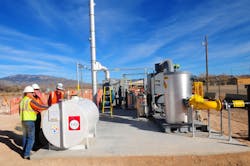Jet Fuel Cleanup System Malfunctions
June 27--Kirtland Air Force Base's big new jet fuel spill cleanup system, intended to slow the spread of base-caused groundwater contamination, has been on the fritz for much of June.
The Air Force shut down the big new "soil vapor extraction" machine May 31, just four months after operations began, after its control system malfunctioned, according to an Air Force report to the New Mexico Environment Department.
The Air Force initially hoped it would only be down for 72 hours, but it ultimately took nearly two weeks to fix, according to correspondence between Kirtland and the Environment Department.
The Air Force got the machine running again June 12. But other problems continue to plague the system, which is now only running intermittently as workers try to fix it, base civil engineer Brent Wilson said in an interview Wednesday.
The machine acts like a giant vacuum cleaner, sucking fuel vapors sitting in the soil beneath Kirtland's aviation fuel facility, where millions of gallons of fuel spilled from a leaky underground pipe over a period of decades.
The Air Force discovered the leak in 1999, and soon after found traces of contamination in the groundwater beneath the site. In 2007, Air Force tests found a large pool of aircraft fuel that had reached the Albuquerque water table, floating atop the groundwater and spreading contamination north and east, toward municipal drinking water wells.
The nearest Albuquerque Bernalillo County Water Utility Authority drinking water well is less than a mile from the closest known area of groundwater contamination. The well, and a monitoring well drilled as a "sentry" between the drinking water and the fuel plume, have showed no contamination. But the Air Force acknowledged in an April report that groundwater contamination is still spreading.
While it cannot remove contamination that has already spread through the groundwater, the soil vapor extraction unit is intended to prevent additional fuel trapped in a soil layer above the groundwater from spreading through the water and making the problem worse.
The system that failed controls the mixture of fuel vapor injected into the machine's furnace, where the contaminants are burned, Wilson said. The control system had been "somewhat problematic" since the system was turned on in January, Wilson said, and finally had to be replaced.
The Air Force initially reported to the Environment Department that the outage was not likely to exceed 72 hours, but fixing the problem ended up taking nearly two weeks.
With the control system now fixed, the Air Force is wrestling with a second problem, Wilson said. The efficiency of the machine's furnace at burning the old fuel pulled from the ground has significantly less than expected, resulting in repeated shutdowns in recent weeks to diagnose the problem, Wilson said.
The new problems come amid concern by state regulators about the cleanup system. In May, the Environment Department sent the Air Force a strongly worded letter complaining that the system as built uses a less effective technology than the one originally proposed by the Air Force. According to the Environment Department, the technology change was made without consulting the state, which is overseeing the cleanup effort.
Air Force officials say they made the switch to meet fire safety codes, because the furnace is located so close to the base's jet fuel loading complex.
Reports to the state offering more detail on the change in the design of the soil vapor extraction system, and early results from its operation, are due to the Environment Department on Friday.
-- Email the reporter at [email protected]. Call the reporter at 505-823-3916
Copyright 2013 - Albuquerque Journal, N.M.




